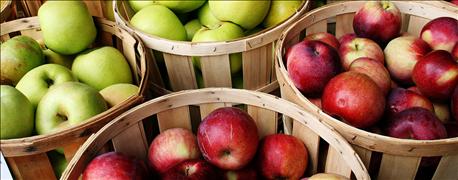October 17, 2016

Each growing season, Michigan State University (MSU) Extension educators coordinate an Apple Maturity Program to measure the quality and maturity of the state’s apples. These weekly analyses assist growers with harvest decisions. Apples are collected from commercial orchards throughout the state in order of varieties’ predicted harvest dates that are estimated using a maturity model, historical data and current season’s weather conditions.

Apples are cut horizontally and stained with an iodine solution to determine starch levels. The iodine binds to starch, showing the ripeness of the apple. A dark stain indicates a less ripe apple.
In collaboration with MSU’s Postharvest Biology and Technology Lab directed by Randy Beaudry, MSU Extension conducts tests to assess ethylene levels, starch index, firmness, color and brix (sugar content) of apple samples. This information is published weekly in the fall in regional and statewide Apple Maturity Reports that growers use to determine when to begin harvesting specific varieties for short- or long-term storage.
Many fresh market apples are put into controlled atmosphere (CA) storage to ensure a constant supply of high-quality Michigan apples year-round. CA storage is classified into three categories: short (less than 3 months), mid (3 to 6 months) and long term (more than 6 months). Ideally, when apples are harvested for CA storage, they meet parameters that determine which storage scenario is optimal. Ethylene level, starch index and firmness are the most important factors for deciding how long apples should be stored.
Ethylene is a naturally occurring gaseous plant hormone, often called the “ripening” hormone, that regulates plant growth and development. MSU Extension uses internal ethylene measurements – the level of ethylene produced inside of the fruit – as one indicator of an apple’s maturity. This measurement is particularly important for CA storage considerations. For long-term storage, 50 percent of the fruit sampled should have ethylene levels below 0.2 parts per million (ppm). If more than 50 percent of fruit are over this 0.2 ppm limit, shorter term storage is suggested.
This concept is similar when using starch index as an indicator for short- or long-term storage. As apples ripen, the starches inside of the fruit are converted into sugars. To measure starch indices, the starch in the exposed flesh of horizontally cut apples is stained with iodine solution. The stained flesh is compared to an established, science-based ranking chart to determine different varieties’ starch indices. Iodine binds with and dyes the starch in the flesh of apples. A dark color indicates the amount of starch present; the darker the flesh, the less ripe the fruit (as shown in the picture). Depending on variety, an average starch index of 2.5–5 is a sign that fruit are ready for long-term storage, whereas shorter storage is recommended for fruit with higher indices (5.5–7).
Apple firmness is measured in pounds of pressure needed to puncture the flesh (without skin) to a depth of 8 mm using a standardized probe 7/16 inches in diameter. Monitoring firmness over time helps growers track when fruit begin softening drastically – a precursor of overripeness. Firmer fruit are typically preferred for storage to ensure they will remain crisp when coming out of storage.
In a perfect world, these three parameters would align with good fruit color and brix levels. However, good color can be challenging in Michigan, particularly when conditions are cloudy, when overnight temperatures are warm or both. Hence, growers often wait for fruit to color up or become a touch sweeter to meet customer preference for ripe-looking and ripe-tasting apples. Growers also receive better prices for high-quality apples with good color.
Visit apples.msu.edu to access Apple Maturity Reports and additional information on postharvest storage recommendations.
Pochubay is an MSU Extension fruit educator. She can be reached at [email protected].
You May Also Like




